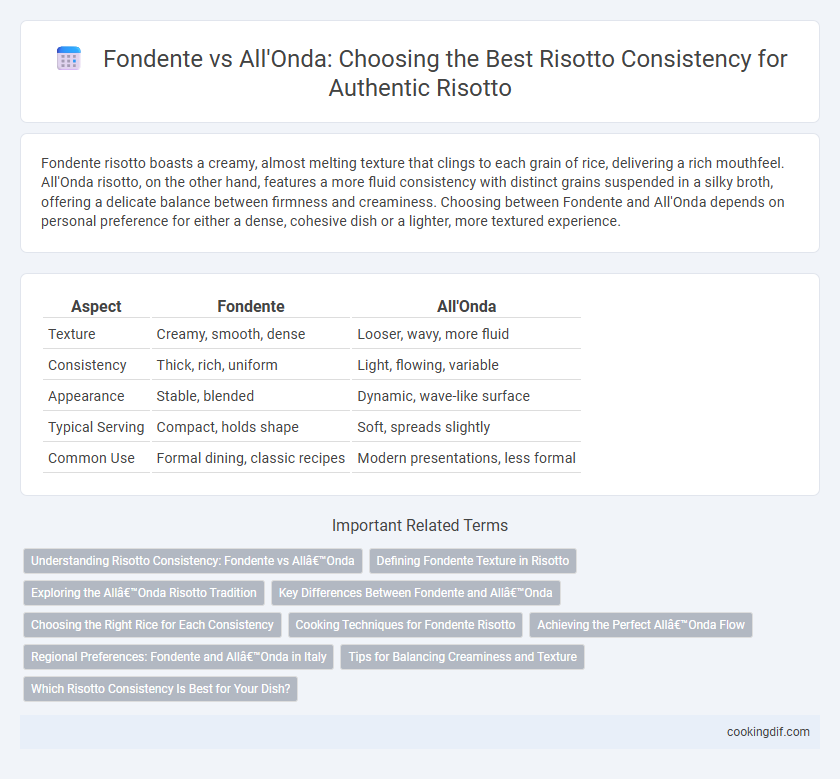Fondente risotto boasts a creamy, almost melting texture that clings to each grain of rice, delivering a rich mouthfeel. All'Onda risotto, on the other hand, features a more fluid consistency with distinct grains suspended in a silky broth, offering a delicate balance between firmness and creaminess. Choosing between Fondente and All'Onda depends on personal preference for either a dense, cohesive dish or a lighter, more textured experience.
Table of Comparison
| Aspect | Fondente | All'Onda |
|---|---|---|
| Texture | Creamy, smooth, dense | Looser, wavy, more fluid |
| Consistency | Thick, rich, uniform | Light, flowing, variable |
| Appearance | Stable, blended | Dynamic, wave-like surface |
| Typical Serving | Compact, holds shape | Soft, spreads slightly |
| Common Use | Formal dining, classic recipes | Modern presentations, less formal |
Understanding Risotto Consistency: Fondente vs All’Onda
Fondente risotto exhibits a creamy, smooth texture achieved by slow cooking and constant stirring, resulting in rice grains that are tender yet whole, with a luxuriously velvety consistency. All'Onda risotto is characterized by grains that remain distinct and slightly firm, swimming in a broth that gently undulates like waves, emphasizing a balance between creaminess and solidity. Understanding these textures helps chefs tailor their risotto technique to achieve either a rich, melt-in-the-mouth Fondente or a more structured, lively All'Onda consistency.
Defining Fondente Texture in Risotto
Fondente risotto is characterized by its creamy, smooth, and velvety texture that coats the grains without being overly liquid or runny. This consistency is achieved by carefully controlling the starch release during cooking, allowing the rice to blend harmoniously with the broth to create a rich, thick, and luscious mouthfeel. Achieving the fondente texture ensures each bite offers a luxurious and satisfying experience typical of traditional Italian risotto.
Exploring the All’Onda Risotto Tradition
All'Onda risotto, characterized by its wave-like creamy texture, exemplifies the Italian tradition of achieving a perfectly al dente rice consistency without becoming too thick or clumpy. This technique emphasizes gradual ladling of hot broth, allowing each grain of Arborio or Carnaroli rice to release starch evenly, creating the signature fluid movement on the plate. In contrast, Fondente risotto tends to be denser and more homogenized, offering a richer but less dynamic mouthfeel compared to the light, flowing nature of All'Onda style.
Key Differences Between Fondente and All’Onda
Fondente risotto features a creamy, smooth texture where the grains are fully cooked and gently broken down to create a velvety consistency. All'Onda risotto, by contrast, retains a slightly firmer, al dente bite with a loose, wave-like movement on the plate, emphasizing distinct rice grains coated in a rich sauce. The key difference lies in the fondente's homogeneous creaminess versus all'onda's textured, flowing quality that balances tenderness with structure.
Choosing the Right Rice for Each Consistency
Fondente risotto features a creamy, smooth consistency achieved by using Arborio rice, known for its high starch content that melts into a velvety texture. All'Onda risotto, characterized by grains that remain slightly firm and separated with a gentle wave-like motion, is best made with Carnaroli rice, prized for its balance of starch and firmness. Selecting Arborio for Fondente promotes luscious creaminess, while Carnaroli's structure supports the delicate bite essential for All'Onda consistency.
Cooking Techniques for Fondente Risotto
Fondente risotto achieves a creamy, melt-in-the-mouth consistency by gradually adding warm broth while continuously stirring, allowing the rice to release its starch evenly. This slow, attentive technique contrasts with the lighter, slightly al dente texture of all'onda risotto, which uses less stirring and a more rapid liquid absorption. Mastering the fondente method requires patience and precise temperature control to ensure the rice grains become tenderly soft without breaking apart.
Achieving the Perfect All’Onda Flow
Fondente risotto has a thicker, creamier consistency resembling a dense custard, while All'Onda risotto achieves a perfect flowing wave texture that is delicate and fluid. Achieving the All'Onda flow requires precise timing in broth addition and continuous stirring to release the starches evenly from the Arborio rice. Mastering this balance enhances the risotto's silkiness and creates the signature gently undulating surface that defines authentic Italian risotto.
Regional Preferences: Fondente and All’Onda in Italy
In Italy, fondente risotto, characterized by a creamy and smooth texture, is predominantly favored in northern regions like Lombardy and Piedmont, where richness and a velvety consistency are prized. All'onda risotto, with its flowing and slightly loose texture, is more commonly preferred in Veneto and Friuli Venezia Giulia, emphasizing an al dente bite and a lighter mouthfeel. These regional preferences reflect local culinary traditions and ingredient availability, influencing how risotto consistency is achieved and enjoyed across Italy.
Tips for Balancing Creaminess and Texture
Risotto Fondente achieves a rich, velvety creaminess by incorporating additional butter and cheese, creating a smooth and dense texture ideal for indulgent dishes. Risotto All'Onda emphasizes a slightly looser consistency with individual grains suspended in a silky, flowing sauce, requiring precise control over liquid absorption and stirring technique to maintain the perfect balance. To optimize creaminess and texture, use quality Arborio or Carnaroli rice, monitor gradual liquid incorporation, and finish with gentle folding to enhance silkiness without overcooking the grains.
Which Risotto Consistency Is Best for Your Dish?
Fondente risotto offers a creamy, velvety texture that is ideal for rich, saucy dishes requiring a smooth mouthfeel. All'Onda risotto features al dente grains suspended in a slightly loose, flowing consistency, perfect for lighter preparations where distinct rice grains enhance the dish's structure. Selecting between Fondente and All'Onda depends on the desired balance between creaminess and grain definition to complement the overall flavor profile.
Fondente vs All’Onda for Risotto Consistency Infographic

 cookingdif.com
cookingdif.com